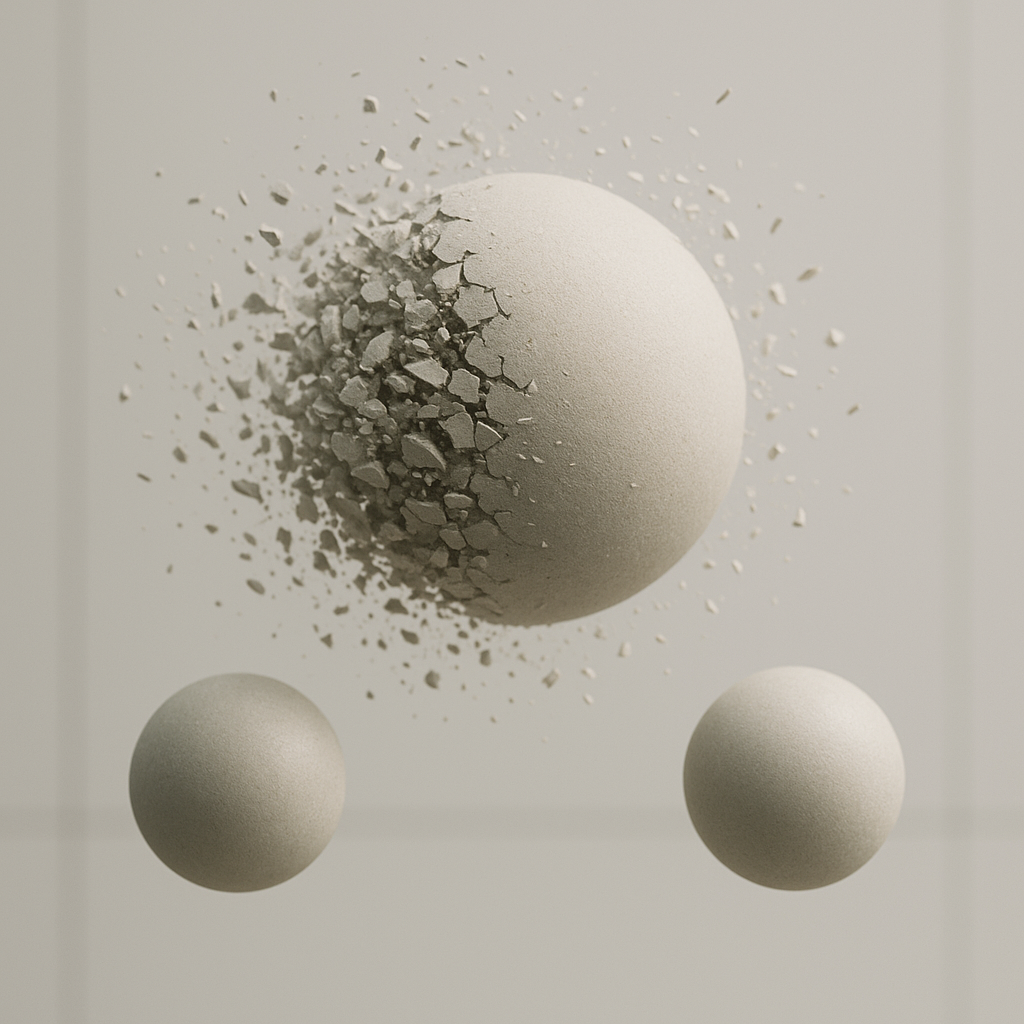Have you ever wondered if it’s possible to split a ball into pieces and magically create two balls of the same size? This bizarre idea is not just science fiction—it’s a real mathematical concept called the Banach-Tarski paradox. In this article, we unravel the mystery and math behind this mind-bending phenomenon and its deeper meaning.
What is the Banach-Tarski Paradox
Imagine holding a solid ball, like a rubber bouncy ball, in your hand. Now, picture cutting this ball into a few pieces—let’s say five. The Banach-Tarski paradox claims that you could take these five pieces and, just by moving and rotating them, put them back together to form not one, but two balls that are exactly identical to the original. Incredibly, both new balls are the same size as the one you started with. You don’t stretch, compress, or distort any piece; you only shift their positions. That sounds impossible, even magical, if not downright suspicious.
What makes this paradox so baffling is that it seems to break the basic rules we learn about matter and volume. How can cutting something up and rearranging the parts give you more than you started with? It clashes with everything our physical intuition tells us. For this reason, mathematicians call it a “paradox”—an idea that defies common sense, but can actually be explained within mathematics. Ironically, as we’ll see, the trick isn’t with the cutting, but with what the pieces really are.
Key Ingredients: Infinity, Set Theory, and the Axiom of Choice
The apparent magic behind the Banach-Tarski paradox comes from deep, counterintuitive properties of infinite sets and modern set theory. Instead of dealing with everyday objects or even familiar geometric shapes, the paradox exploits the strange world of pure mathematics, where our normal understanding of size and structure no longer applies. In this realm, mathematicians use set theory to study collections of points, no matter how vast or fragmented.
A key player here is the axiom of choice. This powerful, but controversial, mathematical principle says that it’s possible to select a single element from each set in an infinite collection, even when there’s no systematic way to make the choices. Banach and Tarski used the axiom of choice to construct the pieces for their decomposition of the sphere. These pieces are not chunks or slices in any regular sense. Instead, they’re infinitely complex, “dust-like” clouds of points—so scattered and tangled that they have no well-defined volume at all. Such bizarre sets are non-measurable, meaning concepts like length, area, or volume simply can’t be assigned to them. Without the axiom of choice, and the infinite complexity of set theory, such decompositions could not exist.
Why Doesn’t the Paradox Work in Real Life
Even though the Banach-Tarski paradox astounds us by suggesting a solid ball can be split and reassembled into two perfect copies, this effect cannot actually happen with real-world objects. The heart of this disconnect lies in the difference between mathematical abstractions and the physical universe. In mathematics, we are free to divide a shape into infinitely many pieces, each as small and strange as needed—even subsets that are so jumbled and dispersed that “piece” barely seems an appropriate word. But real objects are made out of atoms, and there’s a physical limit to how finely we can cut them.
Once we reach scales smaller than atoms or molecules, the notion of dividing matter becomes meaningless in physics. Furthermore, nothing in the real world allows us to manipulate infinite collections of perfect points—there is no way to physically enact the wild rearrangements that the Banach-Tarski paradox relies on. The laws of physics, such as conservation of mass and energy, and the indivisible nature of fundamental particles, prevent such paradoxical duplications. By understanding these limitations, students can distinguish between the boundless logic of mathematics and the tangible constraints of physical matter.
History and Development of the Paradox
The Banach-Tarski paradox emerged from the fertile mathematical environment of early twentieth-century Europe, a period when mathematicians were intensely exploring the foundations of set theory, measure, and geometry. Stefan Banach and Alfred Tarski, working in Poland in 1924, were inspired both by the surprising results of earlier mathematicians and by their own fascination with the newly formalized concepts of infinity and abstract sets. Giuseppe Vitali had previously constructed the first “non-measurable set”—a set of real numbers so wild it defied traditional notions of length. Felix Hausdorff soon extended these ideas to higher dimensions, raising provocative questions about congruence and decomposability.
Banach and Tarski took this further: using the axiom of choice, they devised a carefully constructed argument showing that a solid sphere could, in theory, be dissected into a finite number of non-measurable pieces and reassembled into two identical spheres of the original size. Mathematicians were astonished—how could such a result align with intuition about volume? Debate and excitement soared, with some embracing the axiom of choice’s peculiar consequences and others questioning whether abstract mathematics had wandered too far from sensible reality.
Bigger Questions: What Does the Banach-Tarski Paradox Teach Us
At the heart of the Banach-Tarski paradox lies a profound challenge to our most basic intuitions about space, volume, and what it means to “measure” anything. The paradox does not describe a process we could perform with real, physical objects; instead, it reveals the unforeseen consequences of accepting idealized assumptions like the Axiom of Choice. In mathematics, volume seems a simple concept, yet Banach-Tarski exposes deep cracks in this intuition—by tearing a sphere into a finite number of “pieces” so bizarre they have no meaningful volume, then reassembling them into two identical spheres, we see that in certain mathematical worlds, volume is not preserved.
This is not just a quirk of strange math: it compels us to ask what the concept of infinity really means, and how far we can push the idea of “parts” and “wholes.” These pieces cannot be constructed explicitly or visualized; their existence is purely theoretical. Thus, mathematical abstraction can transcend physical reality, emphasizing that some truths in mathematics are alien to experience. The paradox reveals the limits of intuition and challenges the foundational principles underlying not just geometry, but our very notions of reality.
Conclusions
The Banach-Tarski paradox shows how the logic of advanced mathematics can stretch our imagination beyond everyday experience. While we can’t duplicate basketballs in real life, the paradox teaches us about infinity, abstraction, and the surprising power and limits of mathematical thinking. It reminds us that in mathematics, the impossible can become possible—if we dare to follow the logic.

